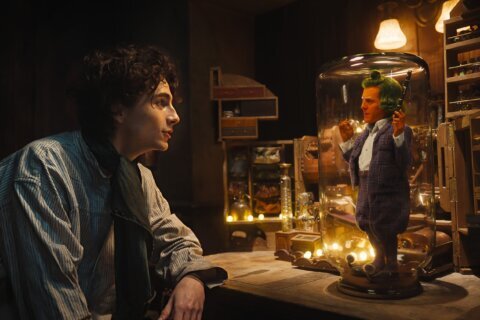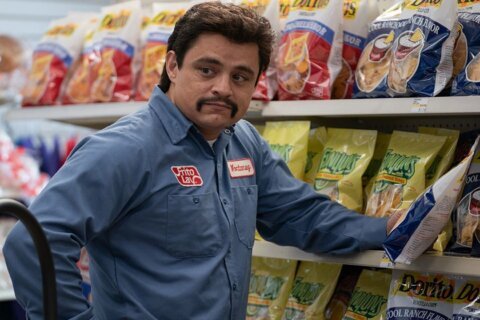WASHINGTON – “The Hunger Games” was the third highest grossing movie of 2012, behind only “The Avengers” and “The Dark Knight Rises.” That means it bested Bond in “Skyfall,” Bilbo in “The Hobbit: An Unexpected Journey” and Bella in “Twilight: Breaking Dawn Part 2.”
On Friday, we welcome the next installment of Suzanne Collins’ best-selling book series, “Catching Fire.” Only this time, Katniss Everdeen and Jennifer Lawrence are coming home winners — Lawrence with an Oscar for “Silver Linings Playbook” (2012) and Katniss holding the proverbial championship belt from the 74th annual Hunger Games.
The film begins with Katniss joining co-champ Peeta Mellark (Josh Hutcherson) on a victory tour of Panem, a futuristic land that was once America before an apocalyptic war. In case you forgot, this land was divided into districts, the poorest of which, District 12 (present day Appalachia), was represented by Katniss in gladiator games run by tyrant President Snow (Donald Sutherland) in an attempt to control his oppressed people.
For the 75th annual games, Snow replaces Seneca Crane with a new gamemaster, Plutarch Heavensbee (Philip Seymour Hoffman), who hatches a sinister scheme called The Quarter Quell, bringing past winners back to face each other in a dense jungle and saltwater lake. This time, it’s Peeta who volunteers as tribute.
The real treat of “Catching Fire” is watching Jennifer Lawrence, whose career has really “caught fire” since her first Oscar nomination for “Winter’s Bone” (2010). And just as last year’s “Hunger Games” preceded her role in David O. Russell’s “Silver Linings,” this year’s “Hunger Games” precedes her role in another Russell film, “American Hustle” (2013), which hits theaters December 18.
The beauty of Lawrence is that she’s slowly redefining the notion of Hollywood leading ladies. They don’t have to be damsels in distress. They don’t have to be scrawny beanpoles. And they don’t have to be diva prima donnas. Lawrence has proven she can kick ass, rock her natural beauty and still be completely down- to-earth off camera, handling Oscar-night falls with grace and humility. You can’t help but root for her. Oh, by the way: she can act her face off.
Lawrence is backed by a deep cast, including mainstays like Woody Harrelson as the drunken mentor Haymitch Abernathy; Liam Hemsworth as Katniss’s old friend Gale Hawthorne; Lenny Kravitz as lavish costume designer Cinna; Elizabeth Banks as the ridiculously dressed Effie Trinket; and Stanley Tucci as TV host Caesar Flickerman, who damn near steals the show like Ryan Seacrest on caffeine pills.
New faces also get their time to shine, from Jeffrey Wright (“Casino Royale”) to Amanda Plummer (Honey Bunny from “Pulp Fiction”), as the contestants compete, form alliances and question trusts with their fellow past winners, sort of like “Survivor All-Stars,” only with, you know, death.
This approach won’t quell the qualm that some have with the “Hunger Games” franchise, that a deadly royal rumble could be treated with such popcorn teen delight. Surely Japan’s “Battle Royale” (2000) treated the bloody subject matter with the gruesome seriousness it deserves. Thankfully, “Catching Fire” rises above such complaints on three main fronts:
- The film gives Katniss a realistic case of PTSD, rendering her unable to shoot and kill a deer, like Jon Voight in “Deliverance” (1972) or Robert DeNiro in “The Deer Hunter” (1978).
- The film ups the ante on the post-modern social commentary about the reality show era, with Katniss and Peeta feigning a relationship for the cameras that’s just as fake as Caesar Flickerman’s laugh on that over-produced stage.
- The film infuses more Mockingjay rebellion themes, with townspeople giving a three-finger salute that might as well be the proverbial “one-finger salute” to Snow’s oppressive regime. This also comes in the form of Cinna’s new outfit for Katniss, designing a dress with Mockingjay wings, revealed in a rear shot resembling Natalie Portman in “Black Swan” (2010).
Much of the credit belongs to a script by two previous Oscar winners: Simon Beaufoy won for “Slumdog Millionaire” (2008) and earned nods for “127 Hours” (2010) and “The Fully Monty” (1997), while Michael Arndt won for “Little Miss Sunshine” (2006) and earned a nomination for “Toy Story 3” (2010). “Catching Fire” is a return to form for both talented writers, after Arndt penned the summer flop “Oblivion” (2013) and Beaufoy penned the medicore “Salmon Fishing in the Yemen” (2011).
We also get a new director this time. Gone is director Gary Ross (“Big,” “Seabiscuit”), who brought a watered down, almost Disney-fied treatment to the first film. This time, we get Francis Lawrence (no relation to Jennifer), who has helmed a much darker streak with “Constantine” (2005) and “I Am Legend” (2007). In “Catching Fire,” Lawrence brilliantly incorporates sound design, moving from noise to silence as Katniss rises to enter the arena and using cannon fire to remind us of the lost lives off screen. Lawrence knows the importance of sound: he got his start directing music videos for Green Day (“Warning”), Britney Spears (“I’m a Slave 4 U”) and Jennifer Lopez (“Waiting for Tonight”), then got a great score from James Newton Howard in “Water for Elephants” (2011).
In “Catching Fire,” the pacing drags as we wait for the games in a 2 1/2 hour runtime that could have been better spent. Once inside the arena, your enjoyment will likely depend on the number of movies you’ve seen, as the filmmakers cover plenty of familiar ground from cinema’s past. Young viewers likely won’t care what came first. Their viewing experience is straight Maximus: “Are you not entertained? Is this not why you are here?” But veteran moviegoers will have moments of deja vu:
- A group of baboons attack like “The Omen” (1976) in a scene that’s far less scary in CGI than it was when real animals dive-bombed Gregory Peck’s car at the zoo. This director had the same problem in “I Am Legend,” which would have been scarier if it used real actors in grotesque make-up instead of CGI zombies scaling buildings with superhuman powers.
- A swarm of birds peck the heroine as her male lover watches helplessly on the other side of a wall like “The Birds.” However, these birds effectively imitate the voices of loved ones.
- A poisonous fog approaches the characters like John Carpenter’s titular haze in “The Fog” (1980) or J.J. Abrams’ smoke monster in TV’s “Lost” (2004).
- A force field prevents passage like Joss Whedon’s horror spoof “Cabin in the Woods” (2012).
- The Show Runner (Philip Seymour Hoffman) changes the environment by flipping a switch and stops just short of drowning his hero like Ed Harris in “The Truman Show” (1998).
- Finally, the slave-to-gladiator-to-revolutionary arc recalls “Ben-Hur” (1959), “Spartacus (1960) and “Gladiator” (2000), only now we must wait four movies to see the journey’s completion. Would the aforementioned movies be classics if they ended before Heston’s chariot race, before Douglas’s “I’m Spartacus,” or before Crowe’s showdown with Phoenix? This is why the “Hunger Games” installments aren’t around come Best Picture time. That isn’t a knock against this particular franchise, but rather a lament with overall Hollywood trends. Few stories are self-contained these days, and the product is often weaker because of it.
Which brings us to the anticlimactic end of the 75th Hunger Games. Rather than an ultimate showdown between the competitors, we get a clever “outside the box” twist. While this ups the ante on the anti-Snow rebellion, it cheapens the rest of The Games, despite clever high-angle crucifix imagery. Fans of the books will not be taken by surprise, but casual fans of the films may feel cheated.
This abrupt ending is clearly meant to set up the next installment, “Mockingjay,” which will be divided into two movies slated for 2014 and 2015. This is the same release strategy that “Twilight” took for its “Breaking Dawn” finale, and in a way, “The Hunger Games” is an extension of this same fan base. The key difference is that it boasts a level of performance never reached in “Twilight.” Robert Pattinson and Josh Hutcherson may be cut from the same mold, but Kristen Stewart is no Jennifer Lawrence.
Perhaps the better comparison, then, is the “Harry Potter” series (2001-2011), which also adapted a series of hit novels, divided its final chapter into two movies (“Deathly Hallows” Part 1 and 2) and combined its rising stars (Daniel Radcliffe, Emma Watson, Rupert Grint) with talented veteran actors (Richard Harris, Alan Rickman, Gary Oldman, Ralph Fiennes).
The “Hunger Games” series caught serious fire last year, and its second installment succeeds in leaving us hungry for more. So if last year’s “Hunger Games” was the appetizer, this is a satisfying second course. Here’s hoping that “Mockingjay” will be a delicious third course delivered by the same waiter (director Francis Lawrence), even if it’s prepared by a different chef (screenwriter Danny Strong) and divided onto two dishes (Part 1 and 2).
Bon appetit.
★ ★ ★
The above rating is based on a 4-star scale. See where this film ranks in Jason’s 2013 Movie Guide. Follow WTOP Film Critic Jason Fraley on Twitter @JFrayWTOP, read his blog The Film Spectrum or listen Friday mornings on 103.5 FM.
Follow @WTOP and @WTOPliving on Twitter.








